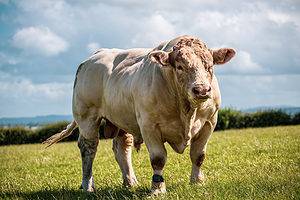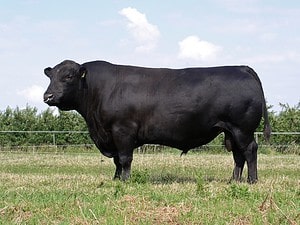One of the oldest foods in the world is cheese, and this hearty milk-crafted delicacy dates back more than 7,500 years. Dozens of cheeses start with C, and many of them may be unfamiliar to you. C-named cheeses get their name from the region where they’re produced or the artisan cheese company that makes them.
After you explore 15 amazing C-named cheeses, don’t be surprised if you start searching for the nearest specialty cheese shop. Find out where these cheeses originated, how they got their names, and how to use them.
Caerphilly
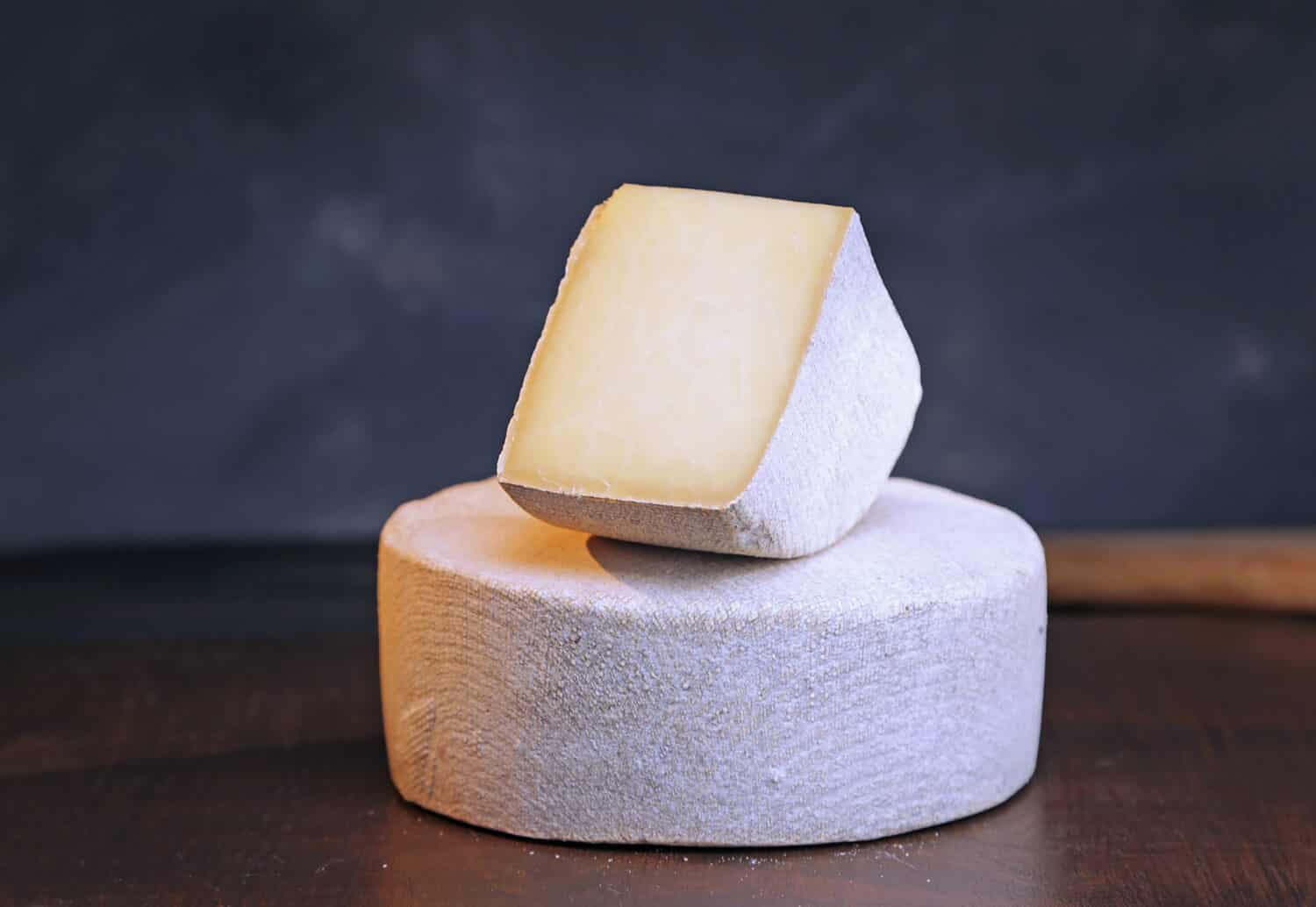
Welsh Caerphilly earned EU PGI status in 2018. Image: Roldugin Dmitry, Shutterstock
©Roldugin Dmitry/Shutterstock.com
Originally made in Caerphilly, Wales, Caerphilly is a hard, crumbly cheese made from milk. A rice flour coating applied prior to curing gives it a white rind. While it has a cheddar-like taste, it’s easier and quicker to make.
Caerphilly’s production moved to England after WWII due to the abundance of cow’s milk in the English countryside. However, Welsh Caerphilly production started back up in the 1980s, and by the 1990s, artisan cheesemakers began making it. The cheese gained EU Protected Geographical Indication (PGI) status in 2018. In honor of the cheese’s ties to the area, a three-day festival celebrates it at Caerphilly Castle.
Cambozola
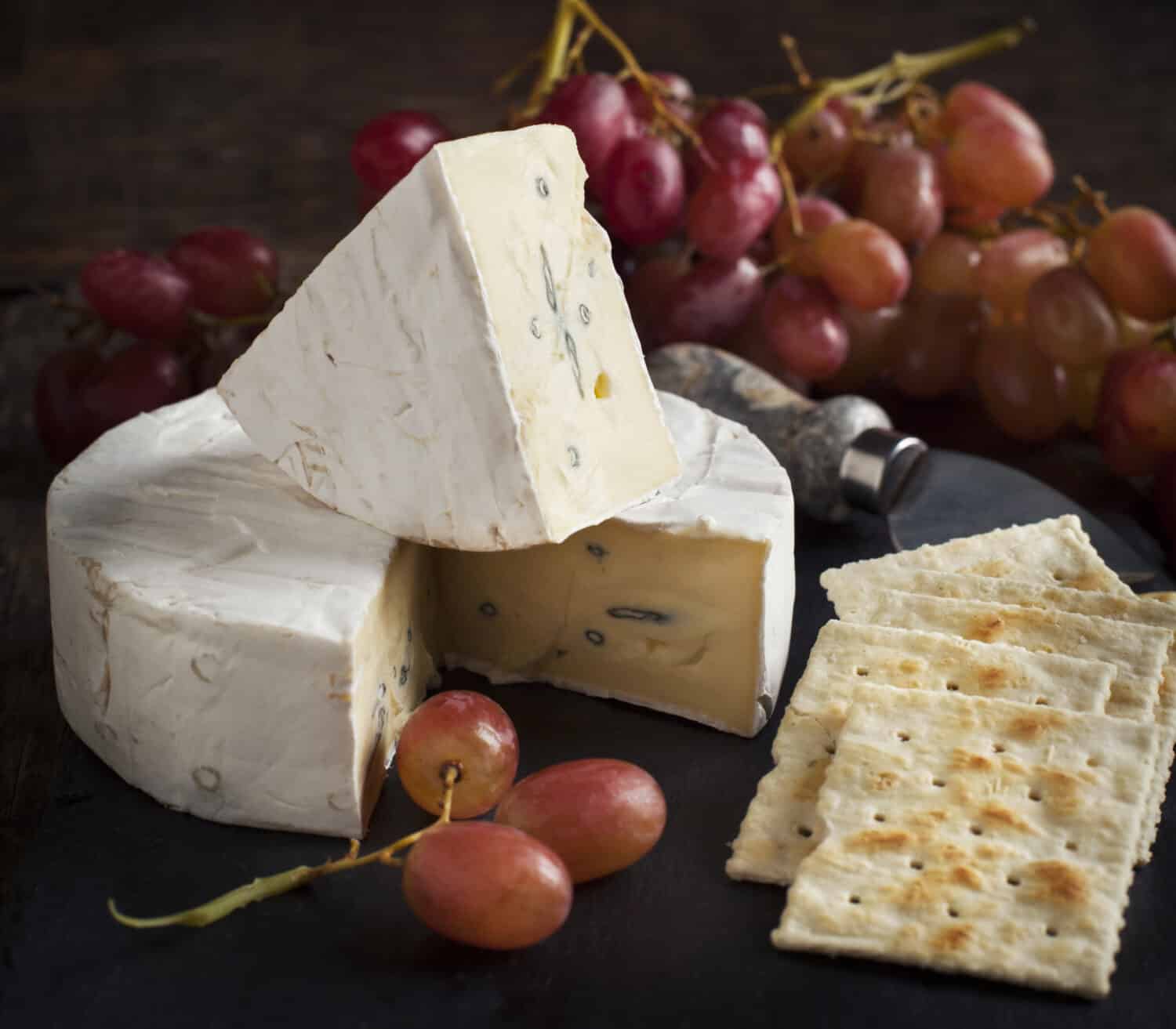
Cambozola merges camembert and gorgonzola. Image: AnjelikaGr, Shutterstock
©AnjelikaGr/Shutterstock.com
Champignon-Hofmeister Group is a family-owned company established in 1908. Cheesemakers crafted a cheese in 1981 using much more cream than usual, similar to the cream levels of a mascarpone. The resulting cheese is a rich, creamy cheese that’s a cross between camembert and gorgonzola.
Cambozola suits fruit and cheese platters, as the sweetness of fruit pairs well with the creaminess and mild blue cheese notes. It’s not as sharp, which makes it a great option for people who dislike the pungency of gorgonzola.
Camembert
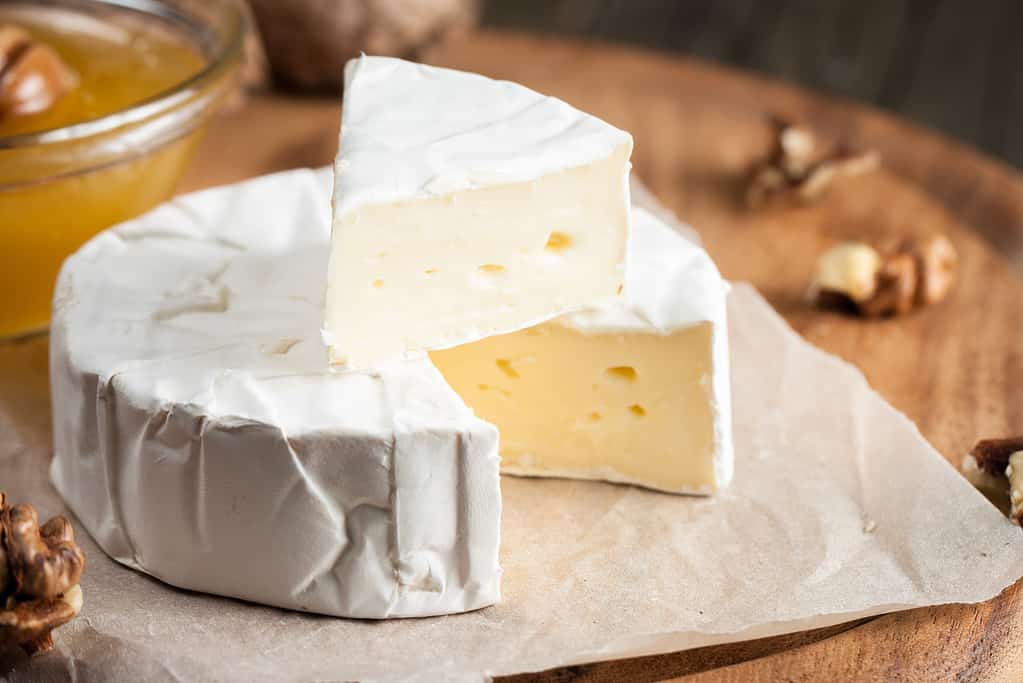
Camembert is a type of brie with less butterfat.
©CreatoraLab/Shutterstock.com
The story is that a Norman dairy farmer, Marie Harel, created Camembert in 1791, and it was named after the village she lived in. Google celebrated this legend with a Google Doodle on her 256th birthday. Allegedly, she learned how to make it from a priest from Brie.
However, there are questions regarding its origins. Pierre Boisard wrote Camembert: A National Myth disproving this legend in 1992. It’s believed that the classic wooden box Camembert comes in wasn’t available until the 1890s. Yet, people still honor her with the creation.
History’s original Camembert used unpasteurized cow’s milk. Aged for just three or four weeks, the cheese’s rind formed with the help of penicillin mold. Today, it’s made with both pasteurized and raw milk.
Canarejal
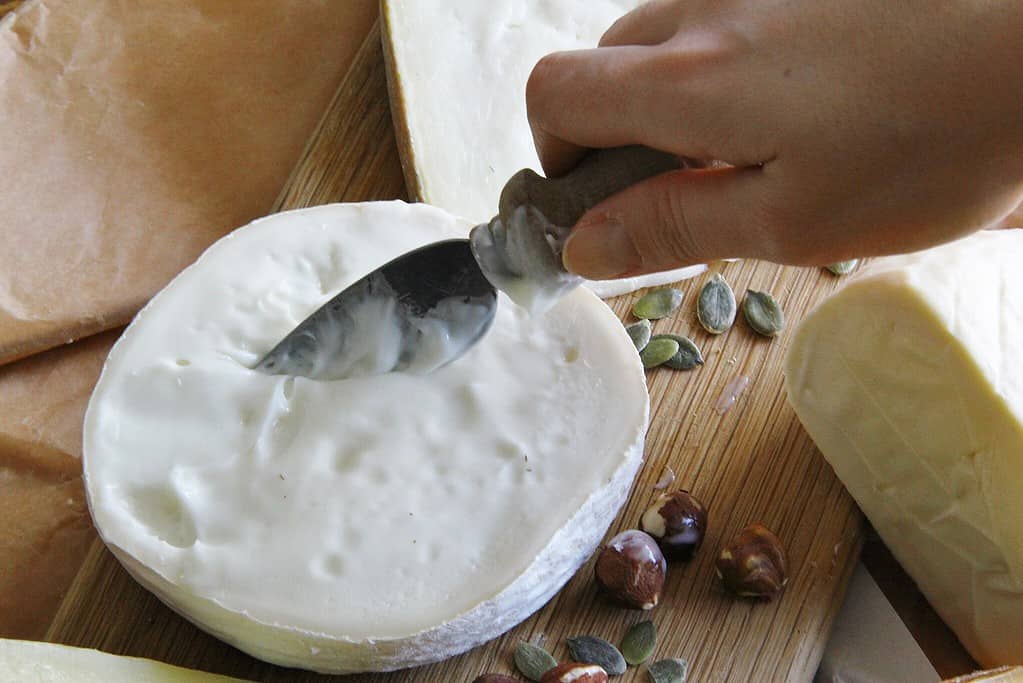
Spain’s Canarejal is a soft cheese made from sheep’s milk.
Canarejal’s soft center requires you to slice off the top rind and eat the creamy cheese with something hard like a breadstick or raw vegetables. Made from raw sheep’s milk and thistle rennet, the mushroom-like notes and creaminess make it unique and unforgettable.
How did it get its name? Canarejal doesn’t mean anything in Spanish, and there’s no town or village with the same name. It was created in Castile, which isn’t similar. The answer is simply that it’s named after the Canarejal cheesemaking company that’s situated in the Riberas de Castronuno Natural Park.
Cantal

Cantal is an uncooked cheese made from either raw or pasteurized cow’s milk.
©Picture Partners/Shutterstock.com
Cheesemakers use either raw or pasteurized milk in Cantal, and the milk dictates the final product’s name. Cantal fermier requires raw milk, while Cantal laitier uses pasteurized. With either, hay-fed Salers cows From the Cantal region provide the milk that’s collected from November 15 to April 15. Milk from the summer months makes Salers cheese.
As the milk isn’t cooked, it’s unsafe for children or the elderly. The crust typically forms listeria as it ages, making it a risky venture for people with weakened immune systems.
Cheddar
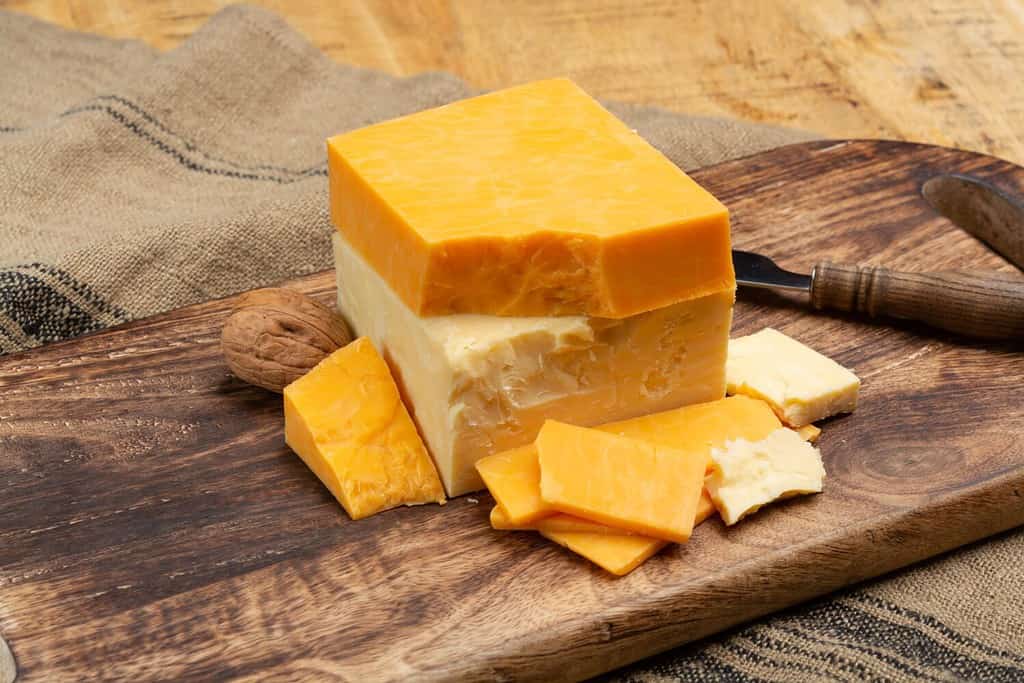
Orange Cheddar’s color comes from the annatto seed.
©barmalini/Shutterstock.com
Somerset, England’s, Joseph Harding developed Cheddar in 1800. At the same time, he invented a mechanical device that could cut curds, which saved time as the process was done by hand until that point. He and his wife also brought Cheddar to North America and Scotland, which helped turn it into a popular cheese around the world.
While the initial Cheddar earned its name from the town of Cheddar in Somerset County, many areas developed their own takes on this popular cheese. Grafton Cheddar (Vermont) and Orkney Scottish Island Cheddar (Scotland) are examples. But, there are only three types of Cheddar: mild, sharp, and extra sharp.
Cheshire
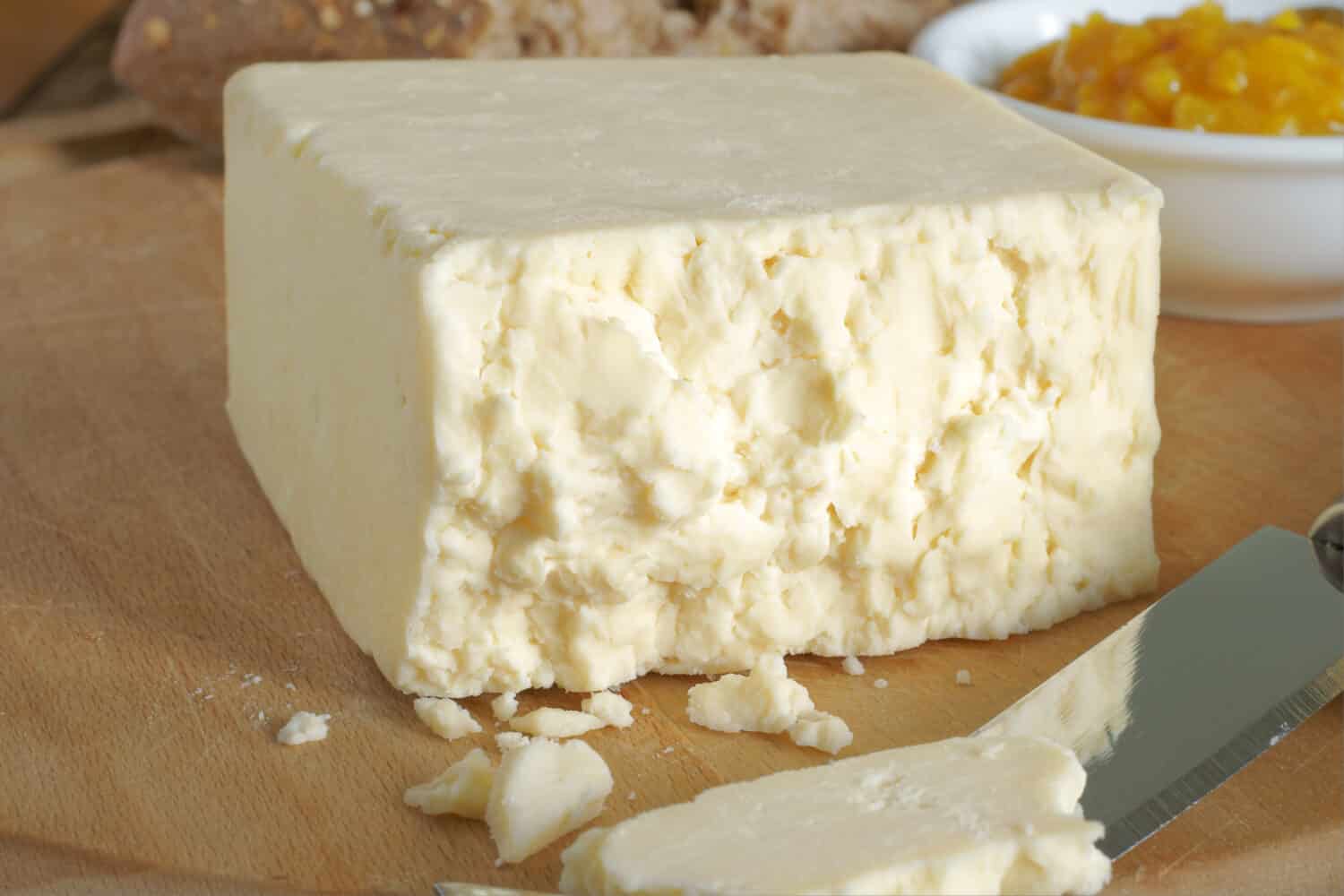
Cheshire is one of the oldest cheeses in England. Image: David Pimborough, Shutterstock
©David Pimborough/Shutterstock.com
Cheshire is a British staple and is named one of England’s oldest cheeses. One of the first recorded mentions was in Thomas Muffet’s Health’s Improvements in the late 1500s. In it, he made a statement about Cheshire’s “cheefes” being comparable to cheese from Holland.
Nantwich Museum explains that milk supplies in the Nantwich region were plentiful in the summer but less so in the winter. Surplus milk supplies were turned into cheese to prevent waste. Salt acted as a preservative. As this region was part of Cheshire County, the cheese received a location-based name.
Chevre

Chevre is a soft goat cheese that pairs well with fruit, which helps cut the tangy flavor.
©New Africa/Shutterstock.com
The French term for goat is chevre, and that’s the reason for this cheese’s name. As goats are rugged animals, they thrive in mountainous areas that challenge sheep and cows. Moors living in rocky areas found goat milk useful as a food source, and chevre developed from there.
While goat’s milk consumption dates back to the 1500s in France, chevre wasn’t made in the U.S. until the 1970s. It’s made around the world now, and its creamy white appearance makes it stand out. Goats convert beta carotene into the vitamin A their bodies need, and that keeps beta carotene from reaching their milk.
Colby
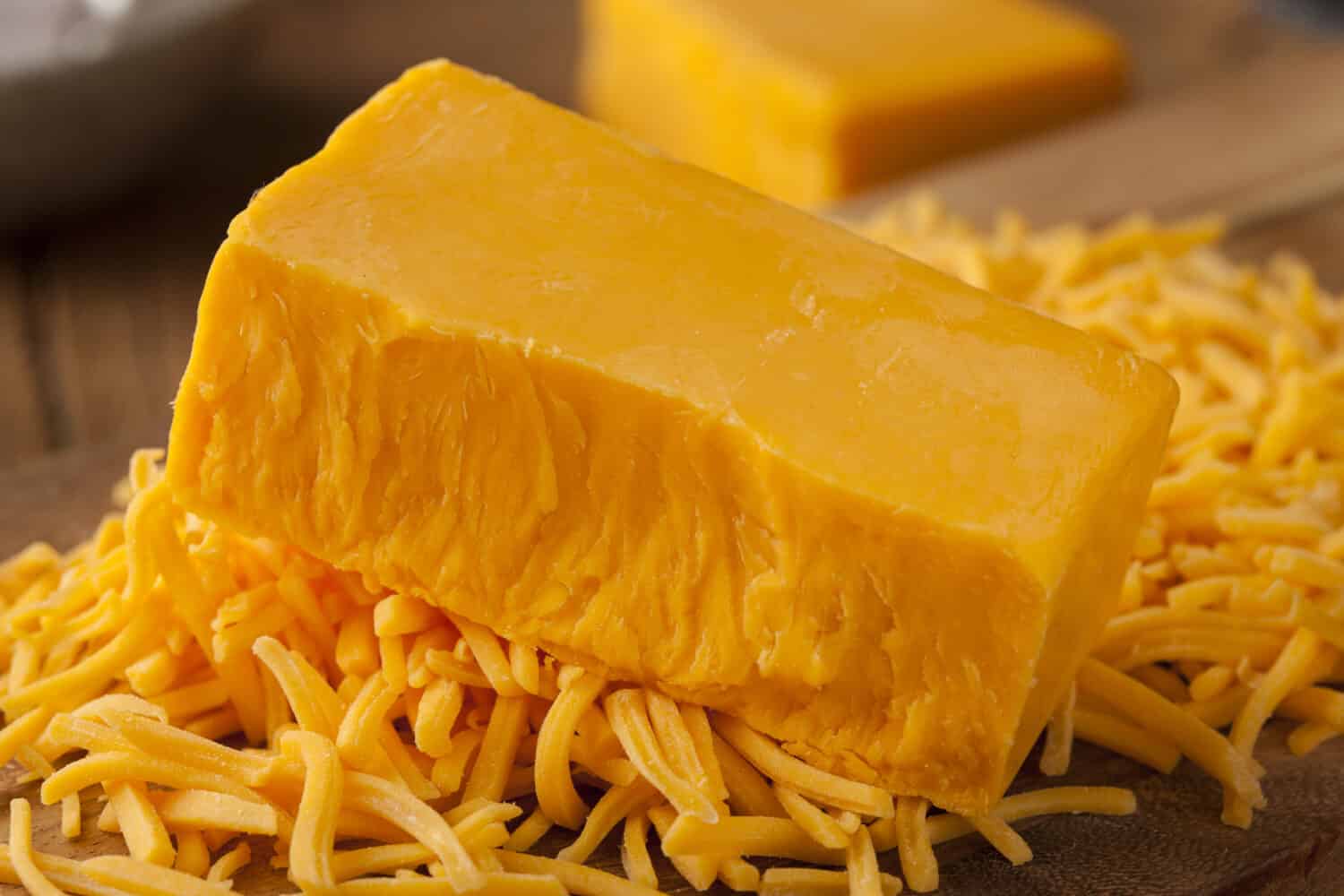
Colby’s yellow coloring helps it stand out in the popular combination with Monterey Jack. Image: Brent Hofacker, Shutterstock
©Brent Hofacker/Shutterstock.com
Wisconsin’s Joseph Steinwand developed Colby for the town his family called home. His father purchased a section of land in Colby and opened a cheese factory, and Joseph started working in that factory when he turned 16.
After attending a cheese-making course, Joseph invented a creamier, milder version of cheddar in 1885. This new cheese was a hit, and most people know it today as the orange cheese paired with Monterey Jack in Colby Jack.
Comte
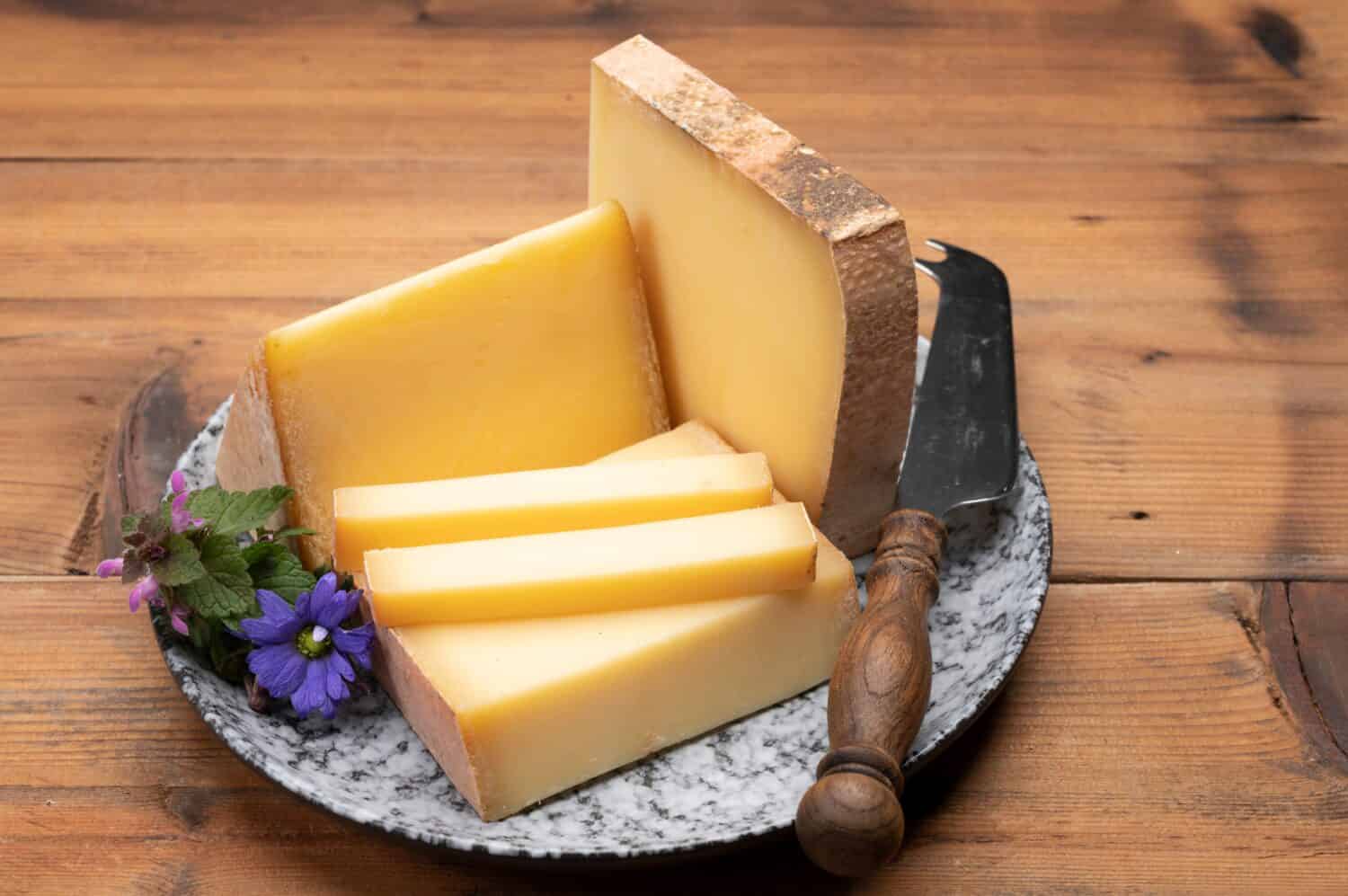
Comte’s rind forms after salt is rubbed on the cheese, and it’s left to age. Image: barmalini, Shutterstock
©barmalini/Shutterstock.com
Raw cow’s milk helps form the creamy flavor of Comte, an Alpine cheese named after the Franche-Comte region in France. Comte is one of the first cheeses with appellation d’origine controlee (AOC) recognition, an honor bestowed on the cheese in 1958.
To make Comte, raw milk must come from French Simmental or Montbeliarde cows that are never fed silage. Rules state there must be no more than 1.3 cows per 2.47 acres. Before it ages, salt is added to the outside of the cheese, it’s never mixed into the coagulated milk.
Cotija
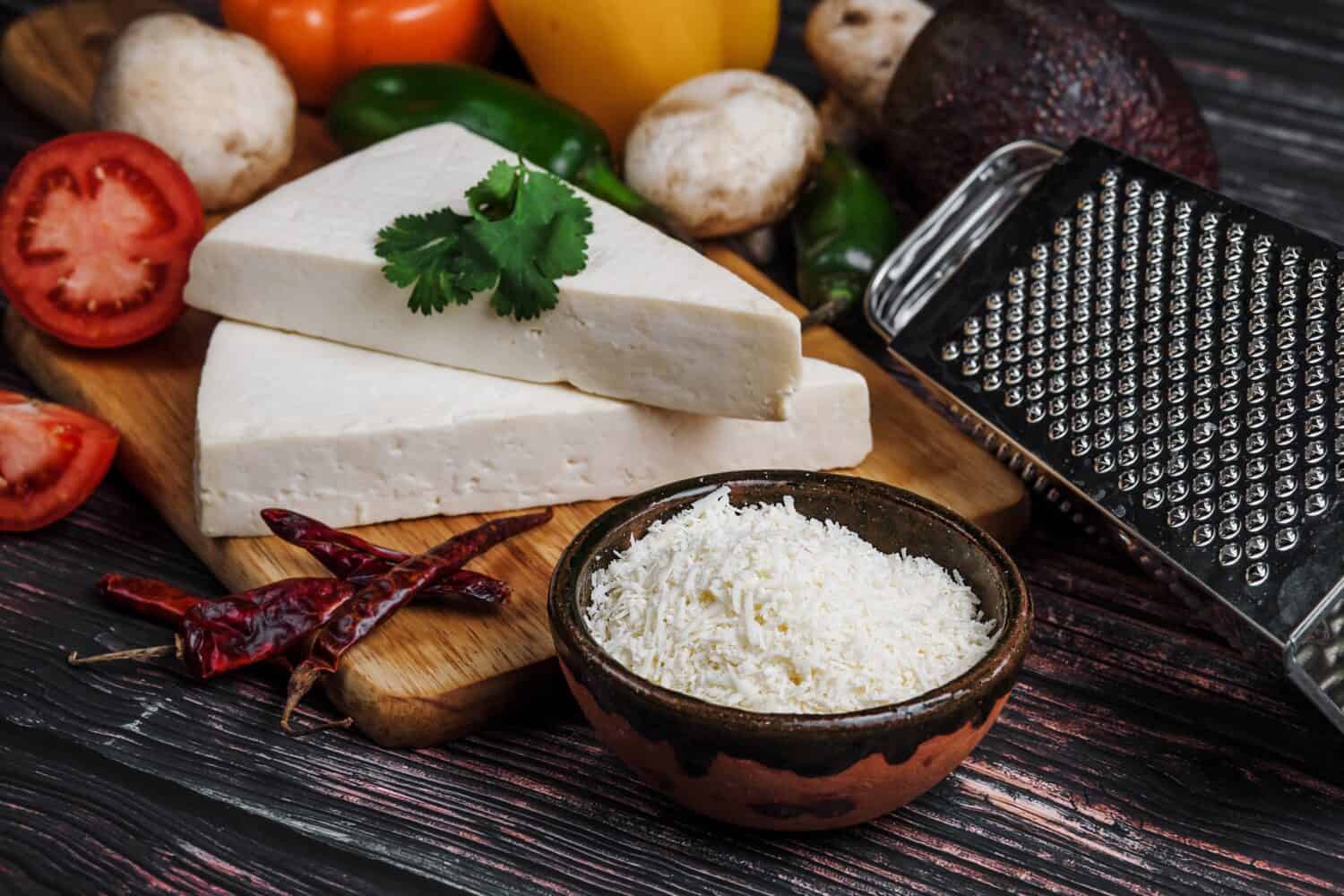
Salty cotija is almost as hard as Parmesan. Image: Marcos Castillo, Shutterstock
©Marcos Castillo/Shutterstock.com
Named for the town of Cotija in the Mexican state of Michoacan, Cotija cheese is a salty, creamy hard cheese. A lot of cheesemakers in Mexico still use traditional methods, which means the size of the finished cheese cylinders varies. Its saltiness comes from liberal amounts of salt added before the fermentation process.
It’s a key part of Mexican elote, a dish where grated Cotija and seasonings coat grilled corn on the cob. It always has the salty, creamy taste that’s a popular addition to any Mexican salad, soup, or main entree.
Cotswold
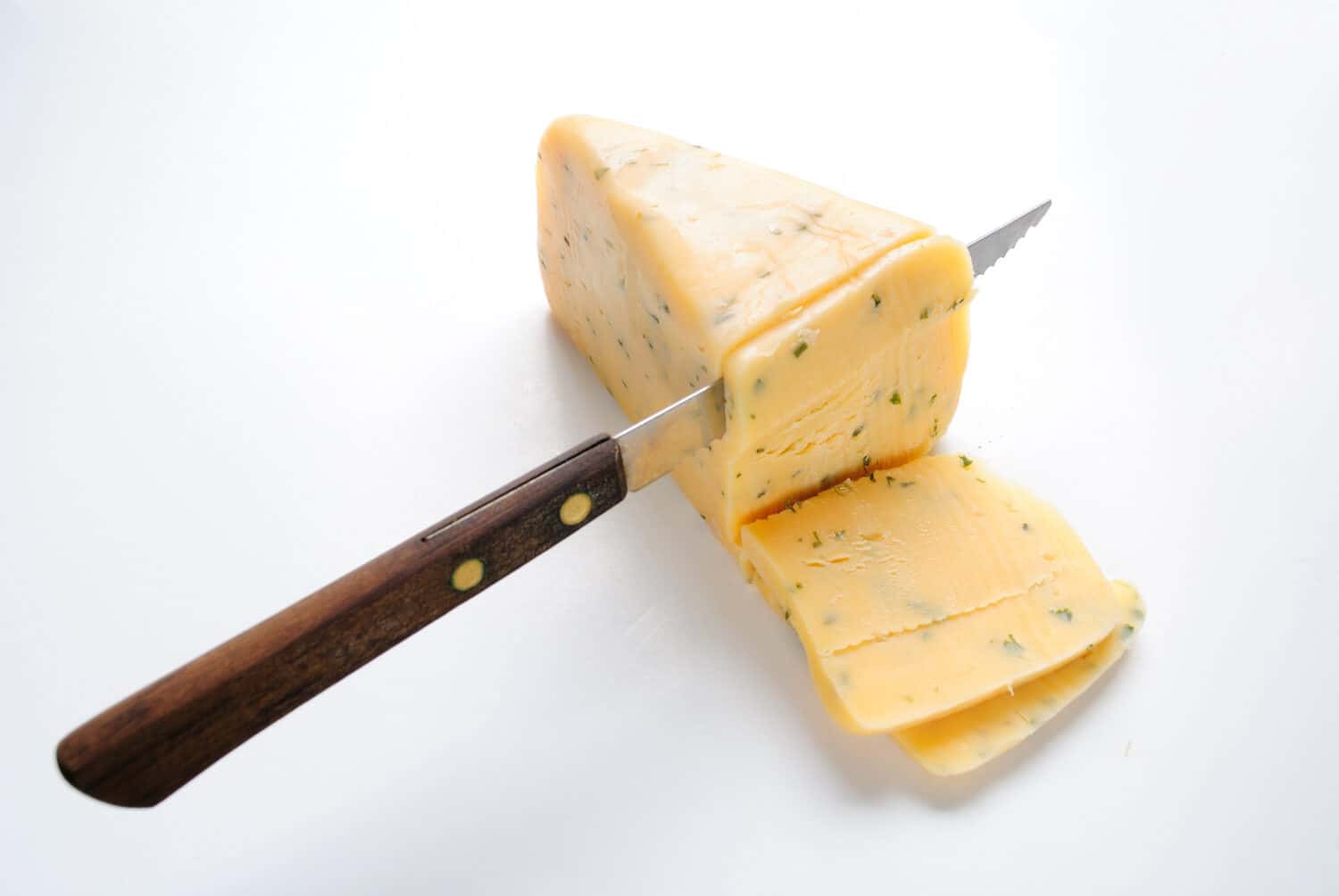
Cotswold is a Double Gloucester with chives adding flavor. Image: Sean Pavone, Shutterstock
©Sean Pavone/Shutterstock.com
Double Gloucester’s high-fat content comes from the use of whole milk and cream. If you add chives and onion to it, it becomes Cotswold. The golden semi-hard cheese gets its name from a Jurassic limestone known as Cotswold stone. Cotswold stone turns golden as it ages.
Add it to cheese plates alongside fresh bread or wheat crackers. It’s versatile and just as good in baked dishes like macaroni and cheese.
Cottage Cheese
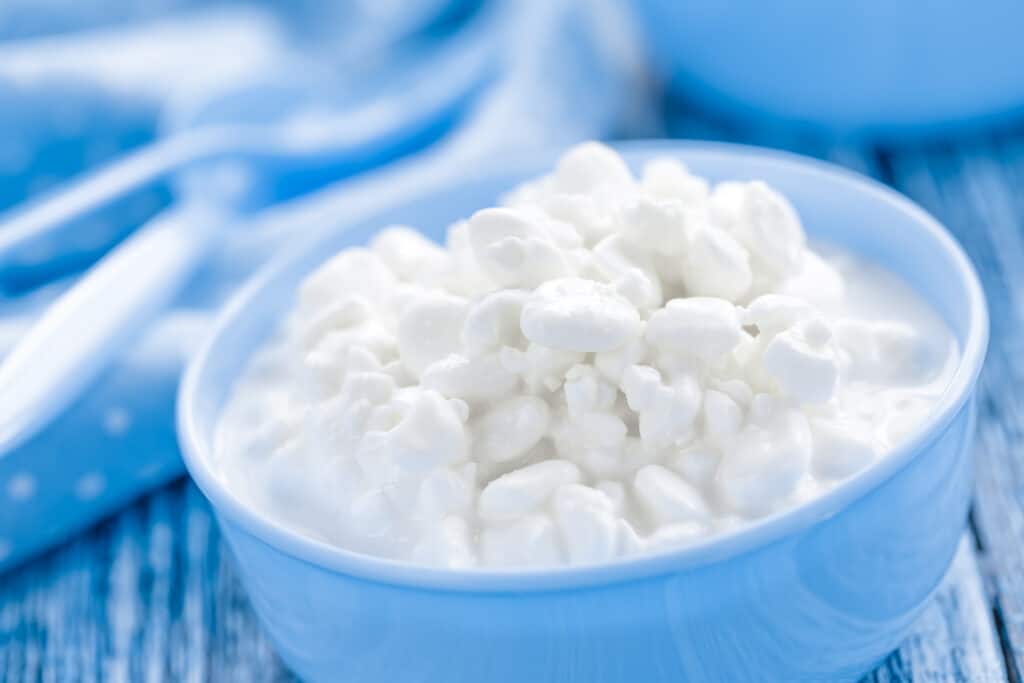
Cottage cheese is one of the most versatile of the cheeses that start with C.
©iStock.com/YelenaYemchuk
Have you encountered Little Miss Muffet who sat eating her curds and whey? She was eating cottage cheese. Make it by curdling low-fat milk, which creates a creamy texture with small curds and a very mild yogurt-like tang.
Cottage cheese supposedly earned its name because cottage owners used leftover milk instead of throwing it out. To make it, they added an acid like lemon juice or vinegar and some salt for flavor. Use it in a variety of cream cheese recipes or eat it on its own.
Cream Cheese

Cream cheese is popular on bagels. Image: Brent Hofacker, Shutterstock
©Brent Hofacker/Shutterstock.com
Whether you have cheesecake, cream cheese frosting on a carrot cake, or a bagel topped with a big spoon of it, cream cheese is a staple in many homes. In fact, it’s a soft cheese you can make at home by heating whole milk and adding rennet, buttermilk, and salt. Wrap it in cheesecloth and press it to expel as much water as possible.
In the late 1800s, a New York dairy worker created Neufchatel but discovered the addition of heavy cream established a richer cheese. Cream cheese was born. It’s a creamy cheese that is never aged and is meant to be consumed as quickly as possible.
Curd Cheese

Curd cheese is mild and comes in small chunks making it a must-have for poutine. Image: Brent Hofacker, Shutterstock
©Brent Hofacker/Shutterstock.com
The shape of curd cheese makes it clear how it got its name. Cheese curds, aka curd cheese, is a by-product of cheesemaking, usually cheddar. After milk mixes with rennet, you have curds. Typically in the cheese-making process, you knead curds together and put them into cheesecloth. Press the formed cheese to expel the water. Curds are bite-sized morsels that do not go through extra processing.
Canadian poutine, which is fries topped with curds and gravy, is a popular way to eat curd cheese. In Wisconsin, deep fry them as a treat, but eating them on their own is just as tasty.
| Cheese Name | Birthplace | Type of Milk | Flavor |
|---|---|---|---|
| Caerphilly | Wales | Cow | Mild and lemony |
| Cotswold | Germany | Cow | Creamy |
| Camembert | France | Cow | Buttery and tangy |
| Canarejal | Spain | Sheep | Sweet and mushroomy |
| Cantal | France | Cow | Buttery and nutty |
| Cheddar | England | Cow | Varies |
| Cheshire | England | Cow | Milky and salty |
| Chevre | France | Goat | Tangy |
| Colby | Wisconsin | Cow | Mild |
| Comte | France | Cow | Mild and sweet |
| Cotija | Mexico | Cow | Salty |
| Cotswald | England | Cow | Oniony |
| Cottage Cheese | Uncertain | Cow | Mild yogurt notes |
| Cream Cheese | New York | Cow | Mild and creamy |
| Curd Cheese | Uncertain | Cotswold | Mild |
Other Cheeses That Start With C
- Cabecou
- Caboc
- Cabrales
- Cachaille
- Cacio de Roma
- Cacio di Bosco al Tartufo
- Cacioavallo (Many options are available with some aged in damp caves and others made with buffalo milk.)
- Caciobarricato
- Caciobirraio
- Caciobufala
- Caciotta
- Cairnsmore
- Calcagno
- Calenzana
- Cambus O’May
- Cana de Cabra
- Canastra
- Cancoyotte
- Cap Cressy
- Cape Vessey
- Capra
- Caprano
- Capraricca
- Caprese di Bufala
- Capri Blu
- Capriago
- Caprice
- Capriny
- Caprotto
- Carabiner
- Caravane
- Carboncino
- Carlina
- Carlow
- Carmody
- Carnia Altobut (Mountain Cheese)
- Caronzola
- Carre de l’Est
- Carre du Vinage
- Casatica
- Casciotta
- Castellano
- Castelmagno
- Castelo Branco
- Castle Blue
- Casu Marzu (Aged with maggots)
- Cathelain
- Cave Rebel
- Cayuga Blue
- Cendre
- Cerney Pyramid
- Chabichou du Poitou
- Chabis de Gatine
- Challerhocker
- Champignon de Luxe
- Chaource
- Charolais
- Chaumes
- Chavroux
- Chelsea Blue
- Cherni Vit
- Chevrotin des Aravis
- Chhurpi
- Chiriboga Blue
- Chocolate Lab
- Chontaleno
- Cilentano ai Fichi
- Cinerino
- Clonmore
- Colony Cheese
- Comtomme
- Conciato al Pepe
- Condio
- Coquetdale
- Corleggy
- Cotherstone
- Coulommiers
- Counting Sheep and Goats and… (Made using three types of milk)
- Coupole
- Couronne
- Coverdale
- Cremet
- Cremig Extra Wurzig
- Cremont
- CreMonte
- CreNoble
- Crescenza
- Cressy Blu
- Criollo
- Crock Cheese (Cold Pack)
- Crotonese
- Crottin
- Crowdie
- Crucolo
- Cuajada
- Cubetto
- Cup Cheese
- Cure Nantais
- Curworthy
Thank you for reading! Have some feedback for us? Contact the AZ Animals editorial team.





